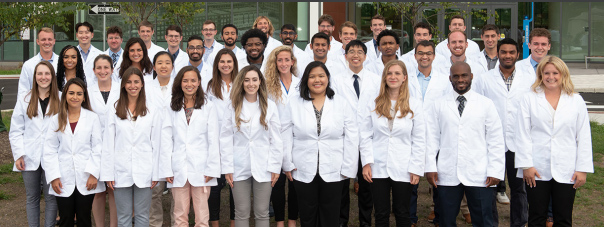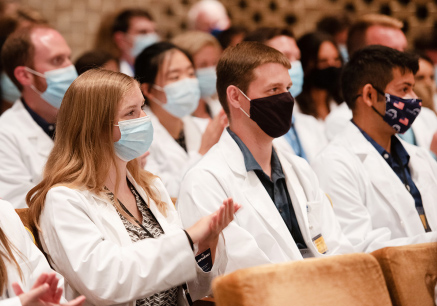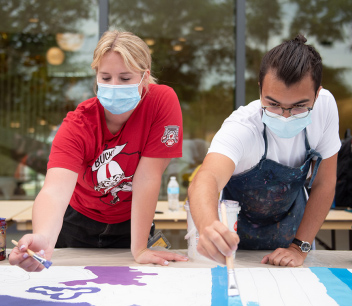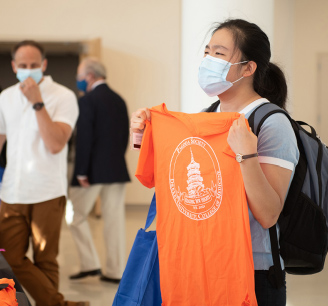West Reading Campus: Celebration and Connection

The mural wall highlighting Drexel’s rich history, with materials from the Legacy Center Archives and Special Collections.
Drexel University College of Medicine welcomed its inaugural class of 40 first-year medical students to the new College of Medicine at Tower Health Campus in August. The campus, located less than one mile and within walking distance to Reading Hospital, had its grand opening the month prior, with attendees from Drexel, Tower Health and the local Reading community.
A VISION REALIZED
Charles B. Cairns, MD, the Walter H. and Leonore Annenberg Dean and senior vice president of medical affairs, expressed enthusiasm about the impact of the campus on its community and on medical education. “The opening of this campus is so gratifying and solidifies our college’s vision for a truly community-integrated medical college that spans urban, suburban and rural populations,” Cairns said at the grand opening. “This campus will serve as the intersecting point of our high-quality medical education, patient care, research and service missions.”
The building includes state-of-the-art medical education technology, including a Simulation Laboratory and a robust standardized patient program that allows students to practice medical interviewing, physical exams and patient counseling. John Repasch, director of standardized patient (SP), clinical skills and simulation, noted, “SPs can help train students on physical exam maneuvers and provide them with real-time guidance and feedback on their techniques. Thus, students can get hands-on experience with real people in a lower-stakes environment, since none of the SPs are actually sick.” He added that the Simulation Laboratory utilizes a SimMan 3G Plus, which offers heightened realism in scenarios that would be unsafe or impossible for a standardized patient, such as a live birth.

The Drexel University College of Medicine at Tower Health inaugural class.
A BUILDING THAT BUILDS CONNECTION
The facility also has a fitness center, library, lounges, game room and café space to enhance student wellness. On the building’s upper floors, large windows and an outdoor seating area offer forest and mountain views. A mural, created by the Legacy Center with materials from its archives and special collections, features images from the College’s legacy institutions, Woman’s Medical College, Medical College of Pennsylvania and Hahnemann University.
“This building and its layout will help the campus to develop community and also encourage our students to make strong connections to faculty, staff and professionals,” said Orcel Kounga, director of admissions and student affairs. Kounga was one of the first administrators hired for the new campus, highlighting the importance of recruiting an inaugural class that would blossom in this environment.
“My goal for the West Reading Campus was to recruit a diverse class that will help create a unique identity at the new location,” he said, adding, “I will be working with the team at West Reading to maximize the success of these students in becoming health professionals.”
Davin Evanson, a member of the class of 2025, noted he looks forward to collaborating with his classmates to sharpen various skills they will use as physicians. “One of my goals during my time in medical school is to practice working effectively as part of a medical team,” he said. “Collaborating with my classmates to analyze cases and make diagnosis and treatment decisions will teach me the communication skills and emotional intelligence I’ll need as I work with colleagues, as well as patients and their loved ones.”
OUTSTANDING EDUCATIONAL OPPORTUNITIES
The class of 2025 will study the same curriculum as their peers at Philadelphia’s Queen Lane Campus; Reading Hospital is one of many sites where all Drexel medical students have the opportunity to complete clinical rotations in their last two years of medical school. The hospital, which was recently named one of U.S. News & World Report top 10 hospitals in Pennsylvania, is Tower Health’s flagship location and the largest hospital between Philadelphia and Pittsburgh. It has been a key site of clinical education for College of Medicine students for more than 20 years.

The incoming students are welcomed by Drexel and Tower Health leaders.
Many alumni laud their time at Reading Hospital as among their most valuable educational experiences. Temi Daramola, MD ’21, said, “A friend of mine had done summer research there, and she raved about how amazing the teaching environment is. Once I got to Reading Hospital it affirmed what she said. Not only is this facility amazing, but teaching was just ingrained in the culture.” Nolan Feola, MD ’21, agreed, noting, “My clinical experience at Reading, I can’t brag about it enough, to be honest. I think one of the best decisions I ever made during my four years of medical school was to come to Reading Hospital for a whole year. This is a place where I never felt afraid to ask questions, a place where I never felt afraid to contribute, a place where I felt like my voice was heard in a lot of the different rotations I went through. I think what a lot of people seek out in medical school is a feeling like they’re in a home away from home, and I felt that while I was there.”
Josette Graves, a member of the class of 2025, said she looks forward to learning how to better serve patients from providers at the hospital. “I hope to learn how to effectively bridge gaps in the system as a medical provider,” she said.“I want to be able to advocate for patients with chronic pain and provide resources so they don’t have to struggle finding specialized health care close to home.”

Students working on the ruOK Berks? mural project.
COMMUNITY ENGAGEMENT
Students are not just learning to provide quality health care during their time in medical school. They are also connecting with the surrounding community. During orientation week, the inaugural class took part in a mural painting activity to get to know their community. Students painted a portion of a mural sponsored by the Berks County Suicide Prevention Task Force, ruOK Berks? The 45-foot-tall mural’s theme is “HOPE.” West Reading and the greater Reading area are home to many murals, and local art teacher Michael Miller showed the public art and downtown West Reading to students, who took a walking tour prior to breaking out their paintbrushes.
West Reading is home to a diverse and underserved community, allowing students to engage with patients with varied backgrounds and life experiences. Throughout their time in school, all Drexel medical students participate in community engagement, lectures and reflective discussions. This work prepares them to address social determinants of health, health disparities and trauma-responsive care and to become communityresponsive physicians.
After deferring medical school for two years to take on a long-term service project, David Talarico, from the MD program class of 2025, is glad that community engagement will be a major part of his medical education. “I know that I will learn a lot in laboratories and am excited to be back in the classroom again, but I also can’t wait to practice patient interaction through community engagement experiences,” he said. “I’m excited to meet and serve people from different backgrounds.”

A student at orientation receives a T-shirt indicating which Learning Society she belongs to. Learning Societies help new students connect in a smaller group environment.
Eugene York, MD, serves as course director for the Health Advocacy Practicum (HAP) for the Reading Campus. He is one of the founders of the Street Medicine Program at Reading Hospital, which provides primary and urgent care to people experiencing homelessness in the community. He emphasized the importance of community engagement through HAP early in a medical student’s training. “There is a saying that goes, ‘You cannot teach empathy, but you can learn it.’ Whether it is at the rescue mission, the soup kitchen, the mobile eye clinic, pulmonary testing, the telehealth kiosk or the tent site, students will see the value in caring for individuals in need, an important part of their medical education.”
First-year MD student Alexis Price-Moyer grew up in West Reading and is excited to return as a medical student. She believes studying medicine in the area will provide her with opportunities to work with patients from varied backgrounds, and to learn how their life experiences affect their approach to health care. “Having a medical college here will absolutely change the lives of those that may not be as fortunate to see a physician due to cost, and it gives the younger population a clear view that they have the option to pursue a career in medicine,” she said. “It touches my heart that I will be able to give back to a community that I love and have a deep connection to.”
Regional Vice Dean Karen Restifo, MD, JD, said the community has welcomed its newest members with open arms. During MD program student orientation week, students took a walking tour of West Reading in their white coats and were stopped by local business owners and other residents who wanted to wish the future physicians well. “It’s daunting to start medical school, and for the students to have been embraced by the community this way is a fantastic help,” Restifo said.
Back to Top